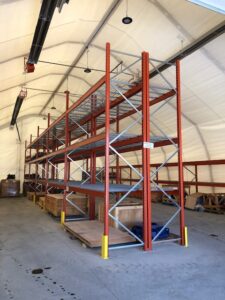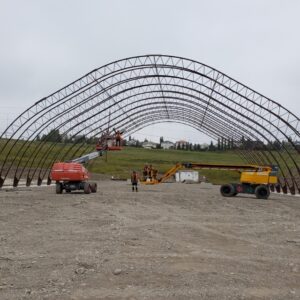When it comes to industrial storage, maximizing efficiency and space is a top priority for businesses. Traditional brick-and-mortar structures often have limitations, such as high construction costs, lengthy installation times, and inflexible designs. However, there is a solution that offers versatility, cost-effectiveness, and rapid construction: fabric buildings. In this article, we will explore the advantages of fabric buildings for industrial storage, discuss how to choose the right one and provide maintenance tips to ensure their longevity.
Understanding Fabric Buildings
Fabric buildings are engineered structures that utilize a high-strength fabric as their primary building material. This high-strength fabric is tensioned over a structural frame, creating a durable and flexible structure. The fabric is typically made of polyethylene or PVC, which offers excellent resistance to UV rays, weather conditions, and wear.
Advantages of Fabric Buildings for Industrial Storage
Cost-Effectiveness
Fabric buildings are significantly more cost effective than traditional construction options. The materials used are generally less expensive, and the construction process is quicker, resulting in reduced labor costs. Additionally, fabric buildings require fewer foundation requirements, lowering overall project costs.
Quick Installation
One of the key advantages of fabric buildings is their rapid installation time. Compared to conventional structures, fabric buildings can be constructed in a fraction of the time. This speed can be critical for businesses needing immediate storage facilities or those operating in time-sensitive industries.
Versatility and Customization
Fabric buildings offer remarkable versatility and customization options. They can be designed to accommodate specific storage needs, whether it’s large open spaces or segmented areas for different products. The interior layout can be adjusted easily, allowing for efficient organization and optimal use of available space.
Energy Efficiency
Fabric buildings are known for their energy efficiency. The translucent fabric allows natural light to filter through, reducing the need for artificial lighting during the day. Additionally, the fabric’s insulation properties help regulate temperature, minimizing the need for excessive heating or cooling, thereby reducing energy consumption and costs.
Durability and Maintenance
Despite their lightweight construction, fabric buildings are highly durable and require minimal maintenance. The fabric membrane is engineered to withstand harsh environmental conditions, including strong winds, heavy snow loads, and UV exposure. Routine inspections and simple cleaning practices can help extend the lifespan of these structures even further.
Choosing the Right Fabric Building
Assessing Storage Needs
Before investing in a fabric building, assessing your specific storage requirements is crucial. Consider factors such as the type and volume of products to be stored, access points needed, and potential future expansion. Understanding these needs will guide you in selecting the appropriate size, layout, and features for your storage building.
Size and Design Considerations
Size and design play a significant role in maximizing the efficiency of your fabric building. Evaluate available space, site constraints, and zoning regulations when determining the dimensions of your structure. Additionally, consider features like doors, windows, insulation, ventilation, and other accessories that can enhance usability and functionality.
Quality and Warranty
Quality is paramount when choosing a fabric building. Look for reputable manufacturers or suppliers, such as FastCover, that use high-quality materials and offer comprehensive warranties. A well-constructed industrial building should provide long-lasting performance and withstand harsh industrial storage environments.
Safety and Compliance
Ensure that the fabric building you choose complies with relevant safety standards and building codes. These structures should meet or exceed local regulations for wind and snow loads, fire safety, and other safety requirements. Consulting with experts or professionals in the field can help ensure compliance and mitigate potential risks.
Maintenance and Care
Regular Inspections
To maintain the integrity of your fabric building, conduct regular inspections. Check for any signs of wear, tears, or damage to the fabric membrane, structural components, and accessories. Promptly address any issues identified to prevent further deterioration and ensure the safety of stored items.
Cleaning and Repairs
Keep your fabric building clean by regularly removing debris, dust, and dirt. Gentle cleaning methods, such as pressure washing or mild detergent solutions, can help preserve the fabric’s appearance and performance. Address any necessary repairs promptly, following the manufacturer’s guidelines or seeking professional assistance.
Fabric buildings have revolutionized industrial storage by offering cost-effective, versatile, and efficient solutions. Their rapid installation, customizable design, energy efficiency, and durability make them a compelling option for businesses seeking to maximize their storage space. By understanding your storage needs, choosing the right fabric building, and implementing proper maintenance practices, you can utilize fabric buildings to optimize your industrial warehouse operations.
FAQs
Are fabric buildings suitable for all types of industrial storage?
Fabric buildings are highly versatile and can accommodate various types of industrial storage needs. However, it’s essential to assess your specific requirements and consult with experts to ensure the fabric building’s suitability for your intended use.
How long does it take to install a fabric building?
The installation time for fabric buildings can vary depending on factors such as size, complexity, site conditions, and weather. However, fabric buildings generally have significantly shorter installation times compared to traditional construction, with some projects taking only a few days to complete.
Can fabric buildings withstand harsh weather conditions?
Yes, fabric buildings are engineered to withstand various weather conditions, including heavy rain, snow, wind, and UV exposure. High-quality fabric membranes and sturdy structural frames provide the necessary durability and resistance to ensure long-lasting performance.
Can fabric buildings be expanded or relocated?
Yes, fabric buildings offer flexibility in terms of expansion and relocation. Depending on the design and construction, these structures can be easily extended or disassembled and moved to a new location, providing adaptability as your storage needs evolve.
How do fabric buildings compare to traditional brick-and-mortar structures in terms of cost?
Fabric buildings are generally more cost effective than traditional construction options. The materials are less expensive, and the reduced labor and construction time contribute to overall cost savings. However, it’s important to consider factors specific to your project and consult with professionals to determine the most cost-effective solution for your industrial storage needs.

